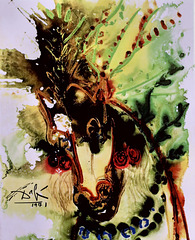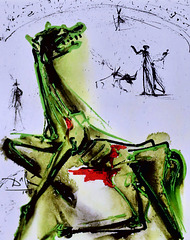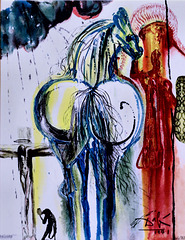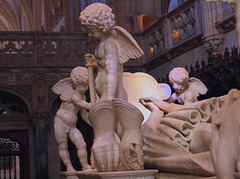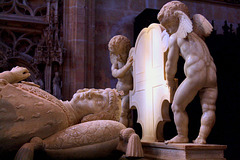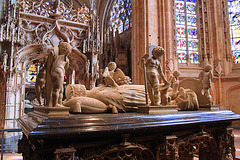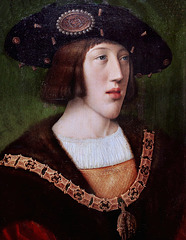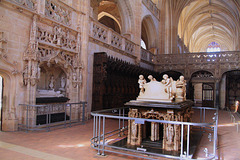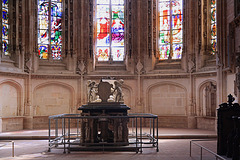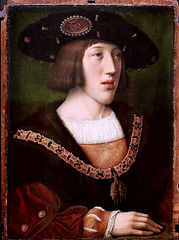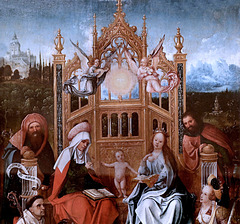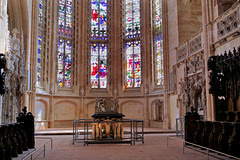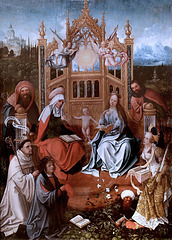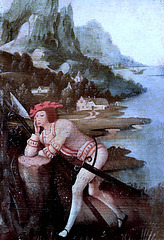Jean Louis Mazieres' photos
IMG 9710 Salvador Dali 1904-1989 Horses (Alexande…
| |
|
Salvador Dali 1904-1989
Horses (Alexander)
Prague National Gallery Exposition temporaire
IMG 9709 Salvador Dali 1904-1989 Horses (The Vict…
| |
|
Salvador Dali 1904-1989
Horses (The Victim of Festivity)
Prague National Gallery Exposition temporaire
IMG 9708 Salvador Dali 1904-1989 Horses (Caligula…
IMG 9707 Salvador Dali 1904-1989 Horses (Woman H…
| |
|
|
|
Salvador Dali 1904-1989
Horses (Woman Horse)
Prague National Gallery Exposition temporaire
IMG 1117CE "Monastère Royal de Brou" "Bourg en Br…
| |
|
|
|
MUSEE BROU
"Le monastère royal de Brou est un chef-d'œuvre de l'art gothique flamboyant flamand du début du XVIe siècle. Il se compose d'un ensemble de bâtiments monastiques construits entre 1506 et 1512, et de la somptueuse église Saint-Nicolas-de-Tolentin de Brou, édifiée de 1513 à 1532 par Louis van Bodeghem.
Cet ensemble architectural rare a été commandé par Marguerite d'Autriche, duchesse de Savoie, gouvernante des Pays-Bas bourguignons, marraine et tante de Charles Quint. Elle fit édifier l'ensemble en mémoire de son époux Philibert le Beau et pour respecter le vœu fait par sa belle-mère Marguerite de Bourbon". Wikipédia
Les anciens bâtiments monastiques comprennent deux cloîtres et abritent le musée de peinture.
L'église sert d'écrin aux trois tombeaux de Philibert le Beau au centre de l'abside, de sa mère Marguerite de Bourbon à droite et de sa femme Marguerite d'Autriche à gauche.
Les deux tombeaux de Philibert le Beau et de Marguerite d'Autriche ont deux étages. A l'étage supérieur le défunt est représenté habillé en costume de cour.
A l'étage inférieur il est présenté nu dans son linceul.
A droite le tombeau de Marguerite de Bourbon mère de Philibert le Beau, dans une niche creusée dans le mur de l'église, comporte un seul étage.
"The royal monastery of Brou is a masterpiece of Flemish flamboyant Gothic art from the early 16th century and consists of a group of monastic buildings built between 1506 and 1512 and the sumptuous church of St. Nicholas. -de-Tolentin de Brou, built from 1513 to 1532 by Louis van Bodeghem.
This architectural ensemble was built on order of Marguerite d'Autriche, Duchess of Savoy, governess of the Burgundy Netherlands, godmother and aunt of Charles Quint. She built the whole in memory of her husband Philibert the Beautiful and to respect the wish made by his mother-in-law Marguerite de Bourbon. "Wikipedia
The ancient monastic buildings include two cloisters and house the painting museum.
The church serves as a showcase for the three tombs of Philibert le Beau in the center of the apse, of his mother Marguerite de Bourbon on the right and his wife Marguerite of Austria on the left.
The two tombs of Philibert the Beautiful and Margaret of Austria have two floors. On the upper floor the deceased is represented dressed in court costume.
On the lower floor he is presented naked in his shroud.
On the right, the tomb of Marguerite de Bourbon, mother of Philibert le Beau, in a niche carved in the wall of the church, has a single floor.
IMG 1117CD "Monastère Royal de Brou" "Bourg en Br…
| |
|
|
MUSEE BROU
"Le monastère royal de Brou est un chef-d'œuvre de l'art gothique flamboyant flamand du début du XVIe siècle. Il se compose d'un ensemble de bâtiments monastiques construits entre 1506 et 1512, et de la somptueuse église Saint-Nicolas-de-Tolentin de Brou, édifiée de 1513 à 1532 par Louis van Bodeghem.
Cet ensemble architectural rare a été commandé par Marguerite d'Autriche, duchesse de Savoie, gouvernante des Pays-Bas bourguignons, marraine et tante de Charles Quint. Elle fit édifier l'ensemble en mémoire de son époux Philibert le Beau et pour respecter le vœu fait par sa belle-mère Marguerite de Bourbon". Wikipédia
Les anciens bâtiments monastiques comprennent deux cloîtres et abritent le musée de peinture.
L'église sert d'écrin aux trois tombeaux de Philibert le Beau au centre de l'abside, de sa mère Marguerite de Bourbon à droite et de sa femme Marguerite d'Autriche à gauche.
Les deux tombeaux de Philibert le Beau et de Marguerite d'Autriche ont deux étages. A l'étage supérieur le défunt est représenté habillé en costume de cour.
A l'étage inférieur il est présenté nu dans son linceul.
A droite le tombeau de Marguerite de Bourbon mère de Philibert le Beau, dans une niche creusée dans le mur de l'église, comporte un seul étage.
"The royal monastery of Brou is a masterpiece of Flemish flamboyant Gothic art from the early 16th century and consists of a group of monastic buildings built between 1506 and 1512 and the sumptuous church of St. Nicholas. -de-Tolentin de Brou, built from 1513 to 1532 by Louis van Bodeghem.
This architectural ensemble was built on order of Marguerite d'Autriche, Duchess of Savoy, governess of the Burgundy Netherlands, godmother and aunt of Charles Quint. She built the whole in memory of her husband Philibert the Beautiful and to respect the wish made by his mother-in-law Marguerite de Bourbon. "Wikipedia
The ancient monastic buildings include two cloisters and house the painting museum.
The church serves as a showcase for the three tombs of Philibert le Beau in the center of the apse, of his mother Marguerite de Bourbon on the right and his wife Marguerite of Austria on the left.
The two tombs of Philibert the Beautiful and Margaret of Austria have two floors. On the upper floor the deceased is represented dressed in court costume.
On the lower floor he is presented naked in his shroud.
On the right, the tomb of Marguerite de Bourbon, mother of Philibert le Beau, in a niche carved in the wall of the church, has a single floor.
IMG 1117CC "Monastère Royal de Brou" "Bourg en Br…
| |
|
|
MUSEE BROU
"Le monastère royal de Brou est un chef-d'œuvre de l'art gothique flamboyant flamand du début du XVIe siècle. Il se compose d'un ensemble de bâtiments monastiques construits entre 1506 et 1512, et de la somptueuse église Saint-Nicolas-de-Tolentin de Brou, édifiée de 1513 à 1532 par Louis van Bodeghem.
Cet ensemble architectural rare a été commandé par Marguerite d'Autriche, duchesse de Savoie, gouvernante des Pays-Bas bourguignons, marraine et tante de Charles Quint. Elle fit édifier l'ensemble en mémoire de son époux Philibert le Beau et pour respecter le vœu fait par sa belle-mère Marguerite de Bourbon". Wikipédia
Les anciens bâtiments monastiques comprennent deux cloîtres et abritent le musée de peinture.
L'église sert d'écrin aux trois tombeaux de Philibert le Beau au centre de l'abside, de sa mère Marguerite de Bourbon à droite et de sa femme Marguerite d'Autriche à gauche.
Les deux tombeaux de Philibert le Beau et de Marguerite d'Autriche ont deux étages. A l'étage supérieur le défunt est représenté habillé en costume de cour.
A l'étage inférieur il est présenté nu dans son linceul.
A droite le tombeau de Marguerite de Bourbon mère de Philibert le Beau, dans une niche creusée dans le mur de l'église, comporte un seul étage.
"The royal monastery of Brou is a masterpiece of Flemish flamboyant Gothic art from the early 16th century and consists of a group of monastic buildings built between 1506 and 1512 and the sumptuous church of St. Nicholas. -de-Tolentin de Brou, built from 1513 to 1532 by Louis van Bodeghem.
This architectural ensemble was built on order of Marguerite d'Autriche, Duchess of Savoy, governess of the Burgundy Netherlands, godmother and aunt of Charles Quint. She built the whole in memory of her husband Philibert the Beautiful and to respect the wish made by his mother-in-law Marguerite de Bourbon. "Wikipedia
The ancient monastic buildings include two cloisters and house the painting museum.
The church serves as a showcase for the three tombs of Philibert le Beau in the center of the apse, of his mother Marguerite de Bourbon on the right and his wife Marguerite of Austria on the left.
The two tombs of Philibert the Beautiful and Margaret of Austria have two floors. On the upper floor the deceased is represented dressed in court costume.
On the lower floor he is presented naked in his shroud.
On the right, the tomb of Marguerite de Bourbon, mother of Philibert le Beau, in a niche carved in the wall of the church, has a single floor.
IMG 1117CBA Barend van Orley. 1488-1551. Bruxelles…
| |
|
Barend van Orley. 1488-1551. Bruxelles.
Portrait de Charles Quint. Portrait of Charles V vers 1516.
Brou. Musée du Monastère Royal
IMG 1117CB "Monastère Royal de Brou" "Bourg en Br…
| |
|
MUSEE BROU
"Le monastère royal de Brou est un chef-d'œuvre de l'art gothique flamboyant flamand du début du XVIe siècle. Il se compose d'un ensemble de bâtiments monastiques construits entre 1506 et 1512, et de la somptueuse église Saint-Nicolas-de-Tolentin de Brou, édifiée de 1513 à 1532 par Louis van Bodeghem.
Cet ensemble architectural rare a été commandé par Marguerite d'Autriche, duchesse de Savoie, gouvernante des Pays-Bas bourguignons, marraine et tante de Charles Quint. Elle fit édifier l'ensemble en mémoire de son époux Philibert le Beau et pour respecter le vœu fait par sa belle-mère Marguerite de Bourbon". Wikipédia
Les anciens bâtiments monastiques comprennent deux cloîtres et abritent le musée de peinture.
L'église sert d'écrin aux trois tombeaux de Philibert le Beau au centre de l'abside, de sa mère Marguerite de Bourbon à droite et de sa femme Marguerite d'Autriche à gauche.
Les deux tombeaux de Philibert le Beau et de Marguerite d'Autriche ont deux étages. A l'étage supérieur le défunt est représenté habillé en costume de cour.
A l'étage inférieur il est présenté nu dans son linceul.
A droite le tombeau de Marguerite de Bourbon mère de Philibert le Beau, dans une niche creusée dans le mur de l'église, comporte un seul étage.
"The royal monastery of Brou is a masterpiece of Flemish flamboyant Gothic art from the early 16th century and consists of a group of monastic buildings built between 1506 and 1512 and the sumptuous church of St. Nicholas. -de-Tolentin de Brou, built from 1513 to 1532 by Louis van Bodeghem.
This architectural ensemble was built on order of Marguerite d'Autriche, Duchess of Savoy, governess of the Burgundy Netherlands, godmother and aunt of Charles Quint. She built the whole in memory of her husband Philibert the Beautiful and to respect the wish made by his mother-in-law Marguerite de Bourbon. "Wikipedia
The ancient monastic buildings include two cloisters and house the painting museum.
The church serves as a showcase for the three tombs of Philibert le Beau in the center of the apse, of his mother Marguerite de Bourbon on the right and his wife Marguerite of Austria on the left.
The two tombs of Philibert the Beautiful and Margaret of Austria have two floors. On the upper floor the deceased is represented dressed in court costume.
On the lower floor he is presented naked in his shroud.
On the right, the tomb of Marguerite de Bourbon, mother of Philibert le Beau, in a niche carved in the wall of the church, has a single floor.
IMG 1117C Barend van Orley. 1488-1551. Bruxelles.…
| |
|
|
Barend van Orley. 1488-1551. Bruxelles.
Portrait de Charles Quint. Portrait of Charles V vers 1516.
Brou. Musée du Monastère Royal
IMG 1117BB "Monastère Royal de Brou" "Bourg en Br…
| |
|
MUSEE BROU
"Le monastère royal de Brou est un chef-d'œuvre de l'art gothique flamboyant flamand du début du XVIe siècle. Il se compose d'un ensemble de bâtiments monastiques construits entre 1506 et 1512, et de la somptueuse église Saint-Nicolas-de-Tolentin de Brou, édifiée de 1513 à 1532 par Louis van Bodeghem.
Cet ensemble architectural rare a été commandé par Marguerite d'Autriche, duchesse de Savoie, gouvernante des Pays-Bas bourguignons, marraine et tante de Charles Quint. Elle fit édifier l'ensemble en mémoire de son époux Philibert le Beau et pour respecter le vœu fait par sa belle-mère Marguerite de Bourbon". Wikipédia
Les anciens bâtiments monastiques comprennent deux cloîtres et abritent le musée de peinture.
L'église sert d'écrin aux trois tombeaux de Philibert le Beau au centre de l'abside, de sa mère Marguerite de Bourbon à droite et de sa femme Marguerite d'Autriche à gauche.
Les deux tombeaux de Philibert le Beau et de Marguerite d'Autriche ont deux étages. A l'étage supérieur le défunt est représenté habillé en costume de cour.
A l'étage inférieur il est présenté nu dans son linceul.
A droite le tombeau de Marguerite de Bourbon mère de Philibert le Beau, dans une niche creusée dans le mur de l'église, comporte un seul étage.
"The royal monastery of Brou is a masterpiece of Flemish flamboyant Gothic art from the early 16th century and consists of a group of monastic buildings built between 1506 and 1512 and the sumptuous church of St. Nicholas. -de-Tolentin de Brou, built from 1513 to 1532 by Louis van Bodeghem.
This architectural ensemble was built on order of Marguerite d'Autriche, Duchess of Savoy, governess of the Burgundy Netherlands, godmother and aunt of Charles Quint. She built the whole in memory of her husband Philibert the Beautiful and to respect the wish made by his mother-in-law Marguerite de Bourbon. "Wikipedia
The ancient monastic buildings include two cloisters and house the painting museum.
The church serves as a showcase for the three tombs of Philibert le Beau in the center of the apse, of his mother Marguerite de Bourbon on the right and his wife Marguerite of Austria on the left.
The two tombs of Philibert the Beautiful and Margaret of Austria have two floors. On the upper floor the deceased is represented dressed in court costume.
On the lower floor he is presented naked in his shroud.
On the right, the tomb of Marguerite de Bourbon, mother of Philibert le Beau, in a niche carved in the wall of the church, has a single floor.
IMG 1117BA "Monastère Royal de Brou" "Bourg en Br…
| |
|
MUSEE BROU
"Le monastère royal de Brou est un chef-d'œuvre de l'art gothique flamboyant flamand du début du XVIe siècle. Il se compose d'un ensemble de bâtiments monastiques construits entre 1506 et 1512, et de la somptueuse église Saint-Nicolas-de-Tolentin de Brou, édifiée de 1513 à 1532 par Louis van Bodeghem.
Cet ensemble architectural rare a été commandé par Marguerite d'Autriche, duchesse de Savoie, gouvernante des Pays-Bas bourguignons, marraine et tante de Charles Quint. Elle fit édifier l'ensemble en mémoire de son époux Philibert le Beau et pour respecter le vœu fait par sa belle-mère Marguerite de Bourbon". Wikipédia
Les anciens bâtiments monastiques comprennent deux cloîtres et abritent le musée de peinture.
L'église sert d'écrin aux trois tombeaux de Philibert le Beau au centre de l'abside, de sa mère Marguerite de Bourbon à droite et de sa femme Marguerite d'Autriche à gauche.
Les deux tombeaux de Philibert le Beau et de Marguerite d'Autriche ont deux étages. A l'étage supérieur le défunt est représenté habillé en costume de cour.
A l'étage inférieur il est présenté nu dans son linceul.
A droite le tombeau de Marguerite de Bourbon mère de Philibert le Beau, dans une niche creusée dans le mur de l'église, comporte un seul étage.
"The royal monastery of Brou is a masterpiece of Flemish flamboyant Gothic art from the early 16th century and consists of a group of monastic buildings built between 1506 and 1512 and the sumptuous church of St. Nicholas. -de-Tolentin de Brou, built from 1513 to 1532 by Louis van Bodeghem.
This architectural ensemble was built on order of Marguerite d'Autriche, Duchess of Savoy, governess of the Burgundy Netherlands, godmother and aunt of Charles Quint. She built the whole in memory of her husband Philibert the Beautiful and to respect the wish made by his mother-in-law Marguerite de Bourbon. "Wikipedia
The ancient monastic buildings include two cloisters and house the painting museum.
The church serves as a showcase for the three tombs of Philibert le Beau in the center of the apse, of his mother Marguerite de Bourbon on the right and his wife Marguerite of Austria on the left.
The two tombs of Philibert the Beautiful and Margaret of Austria have two floors. On the upper floor the deceased is represented dressed in court costume.
On the lower floor he is presented naked in his shroud.
On the right, the tomb of Marguerite de Bourbon, mother of Philibert le Beau, in a niche carved in the wall of the church, has a single floor.
IMG 1117A Barend van Orley. 1488-1551. Bruxelles.…
| |
|
Barend van Orley. 1488-1551. Bruxelles.
Portrait de Charles Quint. Portrait of Charles V vers 1516.
Brou. Musée du Monastère Royal
IMG 1115D "Monastère Royal de Brou" "Bourg en Bre…
| |
|
MUSEE BROU
"Le monastère royal de Brou est un chef-d'œuvre de l'art gothique flamboyant flamand du début du XVIe siècle. Il se compose d'un ensemble de bâtiments monastiques construits entre 1506 et 1512, et de la somptueuse église Saint-Nicolas-de-Tolentin de Brou, édifiée de 1513 à 1532 par Louis van Bodeghem.
Cet ensemble architectural rare a été commandé par Marguerite d'Autriche, duchesse de Savoie, gouvernante des Pays-Bas bourguignons, marraine et tante de Charles Quint. Elle fit édifier l'ensemble en mémoire de son époux Philibert le Beau et pour respecter le vœu fait par sa belle-mère Marguerite de Bourbon". Wikipédia
Les anciens bâtiments monastiques comprennent deux cloîtres et abritent le musée de peinture.
L'église sert d'écrin aux trois tombeaux de Philibert le Beau au centre de l'abside, de sa mère Marguerite de Bourbon à droite et de sa femme Marguerite d'Autriche à gauche.
Les deux tombeaux de Philibert le Beau et de Marguerite d'Autriche ont deux étages. A l'étage supérieur le défunt est représenté habillé en costume de cour.
A l'étage inférieur il est présenté nu dans son linceul.
A droite le tombeau de Marguerite de Bourbon mère de Philibert le Beau, dans une niche creusée dans le mur de l'église, comporte un seul étage.
"The royal monastery of Brou is a masterpiece of Flemish flamboyant Gothic art from the early 16th century and consists of a group of monastic buildings built between 1506 and 1512 and the sumptuous church of St. Nicholas. -de-Tolentin de Brou, built from 1513 to 1532 by Louis van Bodeghem.
This architectural ensemble was built on order of Marguerite d'Autriche, Duchess of Savoy, governess of the Burgundy Netherlands, godmother and aunt of Charles Quint. She built the whole in memory of her husband Philibert the Beautiful and to respect the wish made by his mother-in-law Marguerite de Bourbon. "Wikipedia
The ancient monastic buildings include two cloisters and house the painting museum.
The church serves as a showcase for the three tombs of Philibert le Beau in the center of the apse, of his mother Marguerite de Bourbon on the right and his wife Marguerite of Austria on the left.
The two tombs of Philibert the Beautiful and Margaret of Austria have two floors. On the upper floor the deceased is represented dressed in court costume.
On the lower floor he is presented naked in his shroud.
On the right, the tomb of Marguerite de Bourbon, mother of Philibert le Beau, in a niche carved in the wall of the church, has a single floor.
IMG 1115C Jean de Beer. 1475-1528 environ. Anvers…
| |
|
Jean de Beer. 1475-1528 environ. Anvers.
Sainte Famille avec Saint Bernard, Sainte Catherine
et un donateur.
Holy Family with Saint Bernard, Saint Catherine
and a donor. vers 1505.
Brou. Musée du Monastère Royal
IMG 1115BA "Monastère Royal de Brou" "Bourg en Br…
| |
|
MUSEE BROU
"Le monastère royal de Brou est un chef-d'œuvre de l'art gothique flamboyant flamand du début du XVIe siècle. Il se compose d'un ensemble de bâtiments monastiques construits entre 1506 et 1512, et de la somptueuse église Saint-Nicolas-de-Tolentin de Brou, édifiée de 1513 à 1532 par Louis van Bodeghem.
Cet ensemble architectural rare a été commandé par Marguerite d'Autriche, duchesse de Savoie, gouvernante des Pays-Bas bourguignons, marraine et tante de Charles Quint. Elle fit édifier l'ensemble en mémoire de son époux Philibert le Beau et pour respecter le vœu fait par sa belle-mère Marguerite de Bourbon". Wikipédia
Les anciens bâtiments monastiques comprennent deux cloîtres et abritent le musée de peinture.
L'église sert d'écrin aux trois tombeaux de Philibert le Beau au centre de l'abside, de sa mère Marguerite de Bourbon à droite et de sa femme Marguerite d'Autriche à gauche.
Les deux tombeaux de Philibert le Beau et de Marguerite d'Autriche ont deux étages. A l'étage supérieur le défunt est représenté habillé en costume de cour.
A l'étage inférieur il est présenté nu dans son linceul.
A droite le tombeau de Marguerite de Bourbon mère de Philibert le Beau, dans une niche creusée dans le mur de l'église, comporte un seul étage.
"The royal monastery of Brou is a masterpiece of Flemish flamboyant Gothic art from the early 16th century and consists of a group of monastic buildings built between 1506 and 1512 and the sumptuous church of St. Nicholas. -de-Tolentin de Brou, built from 1513 to 1532 by Louis van Bodeghem.
This architectural ensemble was built on order of Marguerite d'Autriche, Duchess of Savoy, governess of the Burgundy Netherlands, godmother and aunt of Charles Quint. She built the whole in memory of her husband Philibert the Beautiful and to respect the wish made by his mother-in-law Marguerite de Bourbon. "Wikipedia
The ancient monastic buildings include two cloisters and house the painting museum.
The church serves as a showcase for the three tombs of Philibert le Beau in the center of the apse, of his mother Marguerite de Bourbon on the right and his wife Marguerite of Austria on the left.
The two tombs of Philibert the Beautiful and Margaret of Austria have two floors. On the upper floor the deceased is represented dressed in court costume.
On the lower floor he is presented naked in his shroud.
On the right, the tomb of Marguerite de Bourbon, mother of Philibert le Beau, in a niche carved in the wall of the church, has a single floor.
IMG 1115A Jean de Beer. 1475-1528 environ. Anvers…
| |
|
Jean de Beer. 1475-1528 environ. Anvers.
Sainte Famille avec Saint Bernard, Sainte Catherine
et un donateur.
Holy Family with Saint Bernard, Saint Catherine
and a donor. vers 1505.
Brou. Musée du Monastère Royal
IMG 1114CB X Anvers. début du 15è. Soldat endormi.…
| |
|
X Anvers. début du 15è.
Soldat endormi. Soldier asleep.
Brou Musée du Monastère Royal
Le tableau fut autrefois attribué à Joseph Patinir.
The painting was formerly attributed to Joseph Patinir.
Jump to top
- ipernity © 2007-2024
- Help & Contact
|
Club news
|
About ipernity
|
History |
ipernity Club & Prices |
Guide of good conduct
Donate | Group guidelines | Privacy policy | Terms of use | Statutes | In memoria -
Facebook
Twitter

